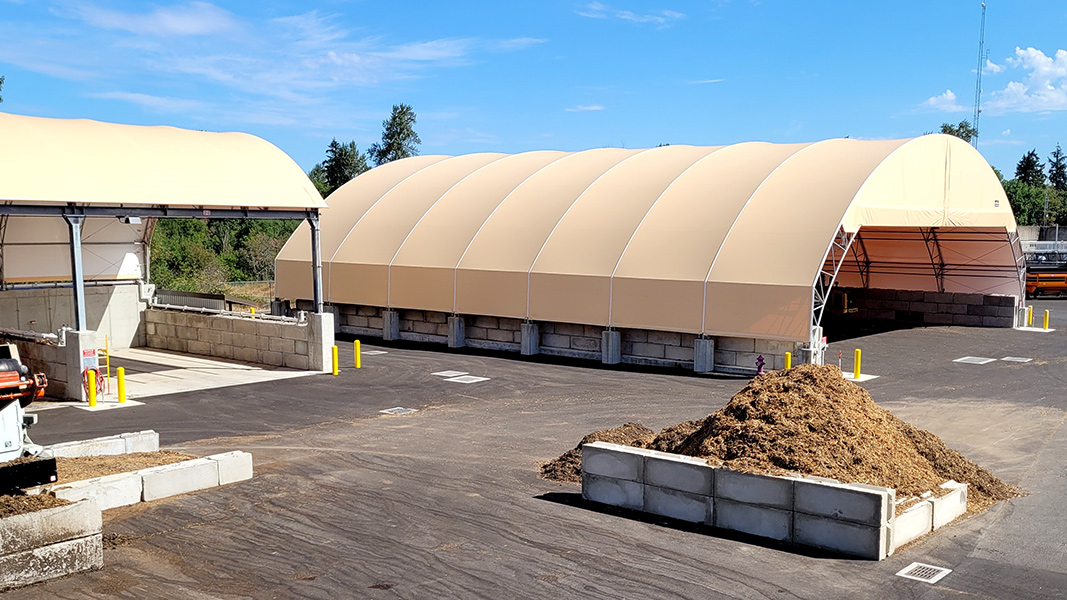Top: The City of Albany’s (OR) biosolids composting facility began full-scale operations in January. An ECS reversing aeration system is housed inside an open-sided fabric structure (on right). Photo courtesy of Albany/Millersburg Water Reclamation Facility (WRF).
The City of Albany, Oregon completed performance testing of its new biosolids composting facility in January 2023 and is gradually ramping up the operation at the city’s Albany/Millersburg Water Reclamation Facility (WRF). Historically, the WRF had been anaerobically digesting wastewater solids produced at the plant and land applying the Class B solids. In 2009, in an attempt to reduce the quantity of biosolids produced, the WRF repurposed old aeration basins by installing a solids reduction system. “The system failed, and since 2009 we were hauling all of our biosolids to the Coffin Butte Landfill,” notes Brian Stevens, Plant Supervisor. “That solution was not sustainable, and in 2015, a year-long composting pilot was conducted to evaluate that process. The results of the study were excellent, and it was decided to move forward with a composting solution.”
The city issued a Request for Proposals (RFP) for dewatering and composting to manage 2,500 wet tons/year (tpy) of biosolids (equal to about 350 to 375 dry tons/year). The WRF required the following in its RFP for composting: Phased system that can be efficiently expanded to accommodate future growth; ability to run positive or reversing aeration, with the intent of piloting what level of aeration is required for a future expansion; and integration of the controls into the WRF’s existing SCADA system. Engineered Compost Systems (ECS) was awarded the contract to install a reversing, biolayer covered aerated static pile system with capacity to process 5,000 tpy. The WRF’s Phase I system includes four zones, which can be operated as primary only (5,000 tpy mix capacity), or split into two primary and two secondary zones (2,500 tpy each). The Phase I aeration system includes capacity for a future four zone expansion. A biofilter to scrub odors was installed. The WRF’s new screw press dewaters the biosolids to about 15% to 18%.

Top: Biosolids cake; bottom: Compile pile in an aerated zone. Photos courtesy of Albany/Millersburg WRF
“Our plan is to compost about 25% of our total production in Phase I in order to ‘master’ the process and establish markets for the compost before increasing the tonnage,” says Stevens. “The remaining biosolids are hauled to the landfill. We’ll gradually ramp up to composting 50% of our production. If we increase beyond that, we may have to move portions of the composting operation off-site as there isn’t a lot of available space at the WRF.” The aerated composting bays are inside an open-sided fabric building to facilitate storm water management. An adjacent fabric structure houses compost curing and product storage.
The WRF purchased a Roto-Mix unit to blend the biosolids with wood chips and green waste procured from Lane Forest Products in nearby Eugene. “Down the road, we also plan to start using hybrid poplar chips from trees grown at several area wastewater treatment plants,” notes Craig Prosser, Wastewater Superintendent. “The trees are fertilized with treated effluent and biosolids.”
Newly mixed biosolids and amendment stay in active composting for 14 to 22 days, and then move into secondary composting under positive aeration only for another 14 to 22 days. The last step is curing without aeration. “In the active phase, we start a batch under negative aeration to best manage odors,” explains Stevens. “We will switch to positive if temperatures near the top of the pile are cooler in order to redistribute the heat.” Finished compost is screened in a Doppstadt trommel to about five-eighth inches. Screened overs are primarily used for a biofilter layer on the aerated static piles; some are blended back into the initial mix as an inoculant.
Initially, the Class A finished compost will be utilized by Albany’s parks and storm water departments and other intergovernmental agencies. Prosser and Stevens have been in discussions with the Oregon Department of Transportation about use of the compost for roadway applications. The WRF will still need to meet with the Albany City Council about establishing a retail price for the finished compost. “All in all, opting to shift to composting is a sustainable solution for the City of Albany’s biosolids,” says Prosser. “The Coffin Butte landfill is projected to be full in four years, and we needed to get out in front of that. Composting is the best option for the ratepayers — having a way to utilize the city’s biosolids versus relying on a landfill that that may close.”













